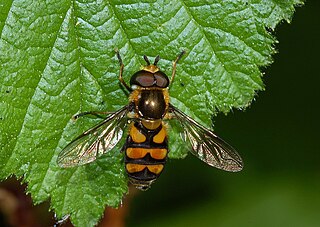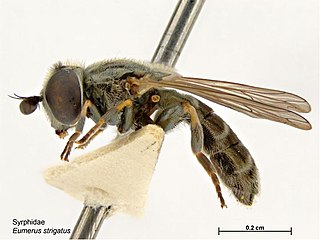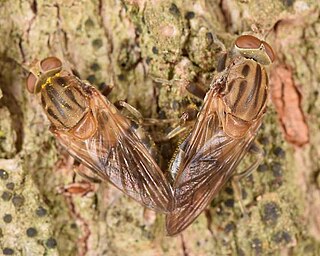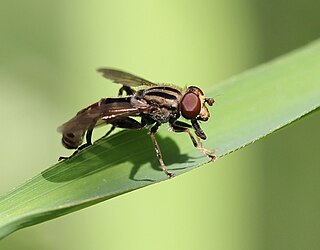
Hover flies, also called flower flies or syrphid flies, make up the insect family Syrphidae. As their common name suggests, they are often seen hovering or nectaring at flowers; the adults of many species feed mainly on nectar and pollen, while the larvae (maggots) eat a wide range of foods. In some species, the larvae are saprotrophs, eating decaying plant and animal matter in the soil or in ponds and streams. In other species, the larvae are insectivores and prey on aphids, thrips, and other plant-sucking insects.

Eristalis is a large genus of hoverflies, family Syrphidae, in the order Diptera. Several species are known as drone flies because they bear a resemblance to honeybee drones.

Eristalinae are one of the four subfamilies of the fly family Syrphidae, or hoverflies. A well-known species included in this subfamily is the dronefly, Eristalis tenax.

Temnostoma is a genus of hoverflies. The larvae of some species feed on the wood of deciduous trees.

Didea fasciata is a Holarctic species of hoverfly.

Cerioidini is a widespread tribe of around 222 species of hoverfly. Cerioidini are mistaken for wasps for which they are effective mimic. Cerioidini have antennae with a terminal style and have somewhat elongate and basally constricted abdomens, only slightly in Ceriana, but pronounced in most Sphiximorpha; and Polybiomyia, and extremely in Monoceromyia. Larvae live mostly within tree sap associated with tree wounds or putrefying pockets of water in tree cavities.

Parasyrphus lineolus is a Holarctic species of hoverfly.

Eumerus strigatus ,, the Onion Bulb Fly , is a fairly common species of syrphid fly observed acoss Europe. Also found in north-central North America and other scattered locations as an introduced species from infested bulbs. Syrphid flies are also known as Hover Flies or Flower Flies because the adults are frequently found hovering around flowers from which they feed on nectar and pollen. The larvae feed on various bulbs. .

Chrysotoxum pubescens the Yellow-throated Meadow Fly is a North American species of syrphid fly in the family Syrphidae.The adults are strong mimics of wasps. Larvae of this species has been described.

Formica subsericea, colloquially known as the black field ant, is a species of ant in the genus Formica. It is found in the eastern United States and Canada. Workers of this species are incredibly fast and quite timid. Workers of this species are commonly found working as slaves in Polyergus colonies. Nuptial flights typically occur in July or August. It is often confused with another Formica species, Formica fusca. The larvae of Microdon megalogaster, a member of the ant fly genus, have been observed in the nests of these ants. The Inquiline relationship of these fly larvae is not well understood.
Criorhina verbosa, the Hairy-cheeked Bumble Fly, is an uncommon species of syrphid fly observed in the eastern to central northeastern United States. Hoverflies can remain nearly motionless in flight. The adults are also known as flower flies for they are commonly found on flowers, from which they get both energy-giving nectar and protein-rich pollen. The larvae of this genus are found in decaying wood.

Chrysogaster antitheus , the Short-haired Wrinkle Fly, is a fairly common species of syrphid fly found in North America. Hoverflies get their names from the ability to remain nearly motionless while in flight. The adults are also known as flower flies for they are commonly found around and on flowers, from which they get both energy-giving nectar and protein-rich pollen. The larvae in this genus are aquatic rat-tailed larvae.

Temnostoma daochus , the Yellow-spotted Falsehorn, is a rare species of syrphid fly observed in the eastern United States. Hoverflies can remain nearly motionless in flight. The adults are also known as flower flies for they are commonly found on flowers, from which they get both energy-giving nectar and protein-rich pollen. Temnostoma adults are strong wasp mimics. The larvae burrow in moist decayed wood.

Syrphus knabi, the The Eastern flower Fly, is an uncommon species of syrphid fly observed in the eastern United States and Canada. Syrphid flies are also known as Hover Flies or Flower Flies because the adults are frequently found hovering around flowers from which they feed on nectar and pollen. Adults are 7.2–12.9 mm (0.28–0.51 in) long. The larvae are predators of a variety of aphids in trees.

Brachyopa vacua , the Yellow-spotted Sapeater, is a rare, species of syrphid fly. It has been observed in Canada, Alaska and northern United States. Hoverflies get their names from the ability to remain nearly motionless while in flight. The adults are also known as flower flies for they are commonly found around and on flowers from which they get both energy-giving nectar and protein-rich pollen. Larvae for this genus are of the rat-tailed type. B.vacua larvae were collected from the juice of decaying fungi under dead bark.

Spilomyia alcimus, the Broad-banded Hornet Fly, is an uncommon species of syrphid fly first officially described by Walker in 1849. Hoverflies get their names from the ability to remain nearly motionless while in flight. The adults are also known as flower flies for they are commonly found around and on flowers, from which they get both energy-giving nectar and protein-rich pollen. The larvae are known as the short-tailed larvae suited for moist areas such as rot holes of trees.
Neoascia globosa , the Black-margined Fen , is a fairly common species of syrphid fly observed in northeastern North America. Hoverflies can remain nearly motionless in flight. The adults are also known as flower flies, for they are commonly found on flowers from which they get both energy-giving nectar and protein-rich pollen. The larvae are aquatic.

Anasimyia distincta, the short-spurred swamp fly, is a rare species of syrphid fly observed in The Northeastern United States and adjacent Canada. Hoverflies can remain nearly motionless in flight. The adults are also known as flower flies for they are commonly found on flowers from which they get both energy-giving nectar and protein rich pollen. Larvae of this genus are of the rat-tailed type living in aquatic environments.

Epistrophella emarginata is a common North American species of hoverfly. Larvae are aphid predators When laying eggs, the female oviposits on the petioles of a leaf.

Eupeodes perplexus, the bare-winged aphideater, is a species of hoverfly native to North America. Adults feed on nectar; larvae feed on aphids and scale insects.


















